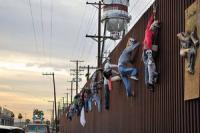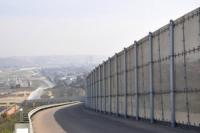-
Proposed border wall will harm Texas plants, animals: Scientists
In the latest publication on the potential impacts of a border wall on plants and animals, conservation biologists say that border walls threaten to harm endangered Texas plants and animals and cause trouble for the region’s growing ecotourism industry.
-
-
Securing U.S. skies
Extended stretches of U.S. land borders invite illegal entry on the ground, and U.S. coastlines are often used for unauthorized seaborne entry. New, creative attempts at illegal activity in these domains are a daily occurrence. Aerial threats pose a different challenge as they have no natural barriers restricting them — land or coastal. Commercialization of drone technology, for all the beneficial opportunities it provides, also enables a new medium for criminal activity and other homeland security threats.
-
-
Using artificial intelligence to predict criminal aircraft
The ability to forecast criminal activity has been explored to various lengths in science fiction, but does it hold true in reality? It could for U.S. Customs and Border Protection (CBP). ) DHS S&T is developing a Predictive Threat Model (PTM) to help CBP’s Air and Marine Operations Center (AMOC) more quickly and efficiently identify and stop nefarious aircraft.
-
-
Border security improvements boost West Bank-Jordan trade
The West Bank and Israel could double trade with Jordan after new security measures were opened at the Allenby border crossing. The new system for scanning cargo containers will enable 200 containers to cross between Jordan and the West Bank each day, double the current number.
-
-
Texas smugglers say Trump's border wall wouldn't stop immigrants, drugs from pouring across the border

If the Trump administration follows through on the president’s promises to build a border wall, would it actually stop undocumented immigrants and illegal drugs? Two former smugglers explain how they’d work around it.
-
-
Administration waives more than 30 environmental laws for New Mexico section of border wall

The Trump administration on Monday waived more than thirty environmental laws to speed construction of twenty miles of border wall in eastern New Mexico, the third time the waiver has been used by the Trump administration. The waiver is meant to allow construction of the New Mexico border wall section without having to comply with laws that protect clean air, clean water, public lands, or endangered wildlife.
-
-
Subterranean Challenge: Revolutionizing underground capabilities
Underground settings are becoming increasingly relevant to global security and safety. Rising populations and urbanization are requiring military and civilian first responders to perform their duties below ground in human-made tunnels, underground urban spaces, and natural cave networks. DARPA two weeks ago announced its newest challenge — the DARPA Subterranean Challenge – to accelerate development of critical lifesaving capabilities.
-
-
The border fence looms over these Texans. Should the government pay them?
Long before President Donald Trump promised to build a wall, Homeland Security used its powers of eminent domain to seize hundreds of acres of land in south Texas to construct a border fence. Under the law, if the government takes or damages your property, it’s supposed to pay to make you whole again. In Texas, the agency has paid $18 million to landholders over the last decade. But scores of Texas landowners who have lived in the shadow of the border fence for years were never compensated for any damage to their property values.
-
-
Revolutionizing subterranean mapping and navigation
Subterranean warfare—whether involving human-made tunnels, underground urban infrastructure, or natural cave networks—has been an element of U.S. military operations from the Second World War and Vietnam to Iraq and Afghanistan. As above-ground commercial and military intelligence, surveillance, and reconnaissance (ISR) capabilities continue to grow more capable and ubiquitous, adversaries are increasingly heading underground to circumvent detection. Rapid global urbanization, furthermore, is accelerating the frequency and complexity of dangerous subterranean environments faced not just by warfighters, but also by emergency responders performing search-and-rescue missions underground: in collapsed mines, for instance, or municipal or urban settings wrecked by natural disaster. DARPA issues a Request for Information which seeks concepts for novel systems and component technologies to disruptively augment military and civilian operations underground.
-
-
Israel demolishes Gaza tunnel, killing 9 Palestinian militants
The Israel military (IDF) on Monday morning destroyed a tunnel Hamas fighters were building under the Israel-Gaza Strip. The Hamas Health Ministry in Gaza said that nine Palestinians were killed and eight others were wounded when the IDF blew up the tunnel. Israel this summer began work on an underground barrier meant to counter attack tunnels.
-
-
CBP completes construction of border wall prototypes
U.S. Customs and Border Protection (CBP) announced Thursday that construction for prototypes of the Border Wall has concluded in San Diego. The prototype construction phase is complete. CBP will now test and evaluate the finished products, provided by industry, to determine which wall design elements meets our needs. This testing and evaluation period will last thirty to sixty days.
-
-
IDF reveals details about Gaza anti-terror tunnel barrier
The Israel Defense Force (IDF) has revealed the extent of the new concrete barrier currently being built around the Gaza Strip. The $836 million concrete barrier aims to eliminate the existing tunnel threat posed by Hamas, as well as any future tunnels that reach into Israel. It will include sensors that can reach dozens of meters into the ground and stand six meters above ground level.
-
-
Construction of first border wall segment to begin sooner than expected along Rio Grande
U.S. Customs and Border Protection will begin constructing the first segment of President Trump’s border wall in November through a national wildlife refuge, using money it has already received from Congress. This is what a U.S. Fish and Wildlife Service official recently told a nonprofit group that raises money to support two national wildlife refuges in South Texas, according to the group’s vice president.
-
-
Border funding bill passes U.S. House; Texans vote along party lines
The U.S. House on Thursday passed about $800 billion in federal spending, including $1.6 billion worth of funding that will go toward constructing a border wall. While there is almost no chance this legislation will become law, Republican lawmakers can head back to their home districts pointing to the wall funding as a legislative step toward a tenet of the Trump presidential campaign.
-
-
Automated security kiosk to shorten lines at airports, border crossings
Researchers have developed a next-generation automated screening kiosk which uses an algorithm of “yes” or “no” questions delivered by a computer-generated avatar, quickly and efficiently to assess the potential threats passengers may pose to others. the screening can be completed in less than four minutes with a 90 percent success rate.
-
- All
- Regional
- Water
- Biometrics
- Borders/Immig
- Business
- Cybersecurity
- Detection
- Disasters
- Government
- Infrastructure
- International
- Public health
- Public Safety
- Communication interoperabillity
- Emergency services
- Emergency medical services
- Fire
- First response
- IEDs
- Law Enforcement
- Law Enforcement Technology
- Military technology
- Nonlethal weapons
- Nuclear weapons
- Personal protection equipment
- Police
- Notification /alert systems
- Situational awareness
- Weapons systems
- Sci-Tech
- Sector Reports
- Surveillance
- Transportation
Advertising & Marketing: advertise@newswirepubs.com
Editorial: editor@newswirepubs.com
General: info@newswirepubs.com
2010-2011 © News Wire Publications, LLC News Wire Publications, LLC
220 Old Country Road | Suite 200 | Mineola | New York | 11501
Permissions and Policies
Editorial: editor@newswirepubs.com
General: info@newswirepubs.com
2010-2011 © News Wire Publications, LLC News Wire Publications, LLC
220 Old Country Road | Suite 200 | Mineola | New York | 11501
Permissions and Policies
